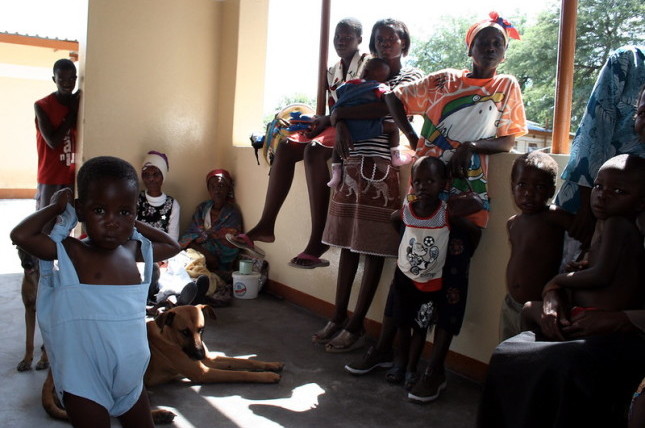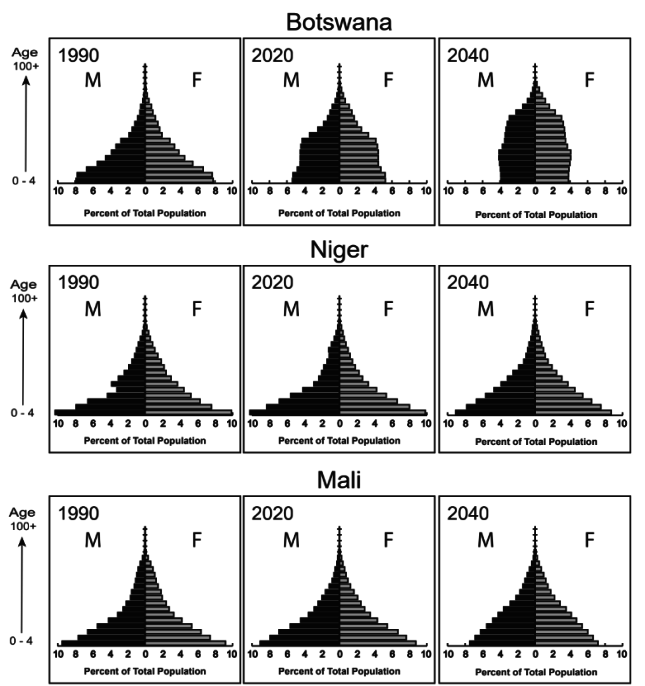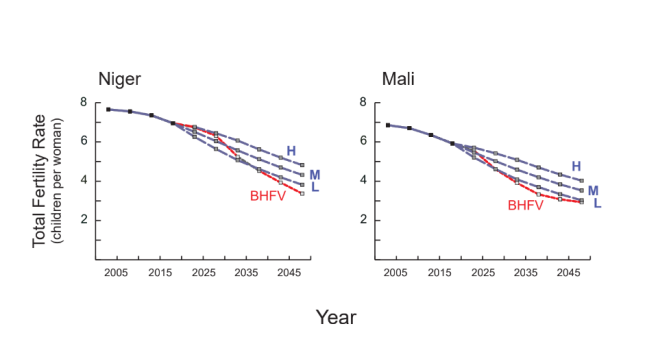-
Emulating Botswana’s Approach to Reproductive Health Services Could Speed Development in the Sahel
January 27, 2020 By Richard Cincotta
The Western Sahel region—a cluster of arid, low-income countries stretching from Senegal, on Africa’s Atlantic coast, inland to Mauritania, Burkina Faso, Mali, Niger, and Chad—is home to the world’s most youthful populations. According to current UN Population Division estimates, about 57 percent of this six-country region’s population is 19 years old or younger. As security conditions deteriorate across the rural Sahel, governments in Europe and North Africa are taking notice of these countries’ demographic status—and for good reasons. Sustained population youthfulness (often called a “youth bulge”) contributes to low levels of educational attainment, joblessness and social immobility, and ultimately to rapid population growth, which tends to drive declines in per-capita availability of freshwater and other critical natural resources: factors that are associated with the risk of persistent violent conflict and represent powerful push factors for migration.
At independence in the early 1960s, these six arid states totaled about 21 million residents. Nearly all were pastoralists or subsistence agriculturalists. Today, amid rapid urbanization, the regional population tops 100 million and is growing by more than 3 million per year. Currently, the UN Population Division’s low and high scenarios for Western Sahel Region, by 2050, project a population between about 210 million and 250 million.
Notably, demographic patterns like those of the Western Sahel do not extend into southern Africa (Fig. 1). In fact, Botswana provides an example of a country that, over the past four decades, has succeeded in substantially reducing the frequency of adolescent pregnancy and early marriage, increase birth spacing, and vastly improving its level of girls’ educational attainment—aspects of development that generally drive improvements in child nutrition and survival, improve maternal health, and initiate a shift to a smaller average family size.
This essay reports on research that investigates what the demographic future might hold for the Western Sahelian states should they emulate Botswana’s pattern of fertility decline.

Botswana’s Family Planning Program
Botswana’s reproductive health effort has been exceptional. Family planning services were first offered free-of-charge in Botswana in the 1970s and have since been integrated into maternal and child health services at local primary health facilities. When last evaluated using USAID’s family planning effort index , Botswana’s program scored highest among all countries surveyed in sub-Saharan Africa. Moreover, the country is one of the few in the region where girls’ secondary school enrollment rate, which is now more than 90 percent, exceeds that of boys.
Whereas in the 1970s and 1980s, Botswana’s health providers and educators coped with high rates of adolescent pregnancy, births among 15- to 19-year-olds have since fallen to less than one-third of their 1980 level. And, by 2007, the prevalence of modern contraception among couples (married or in a union) had surpassed 50 percent, up from pre-1980 levels, which ranged below 20 percent.
The Botswana Projection
How would the Western Sahel region look demographically, had those six countries followed Botswana’s age-specific pattern of fertility decline? As a first step to addressing this question, I generated a model mimicking Botswana’s historical pattern of decline in age-specific rates of childbearing since the early 1970s (Fig. 2). Then, using DemProj (an application within Avenir Health’s Spectrum software), I put Botswana’s historical fertility variant to work to project the future demographic path of the six countries of the Western Sahel.

The development benchmark used in this research was taken from the demographic schema employed by the National Intelligence Council’s Global Trends research. For most countries, Global Trends analyses assume that a median age of 26 years roughly indicates the exit from the difficult-to-manage youthful phase of the age structural transition and the beginning of the transition’s highly favorable intermediate phase—a window of population age structures with a bulge of working-age adults, slowed workforce growth, and relatively low ratios of childhood and senior dependents to workers. Except for the wealthiest oil-and-mineral-endowed states and some of the least populous states (those with populations under 5.0 million), countries rarely achieve the World Bank’s upper-middle income category or attain high levels of child survival and educational attainment without first entering this “demographic window”.
Opening the Demographic Window Early
When applied to the set of Western Sahelian states, the projection that followed Botswana’s historical pattern of fertility decline carved a trajectory that is roughly similar to the UN low variant (see Fig. 3). Although this historical projection slows as it nears a total fertility rate of three children per woman, realizing Botswana’s fertility trajectory would likely bring Sahelian countries into the demographic window up to a decade earlier than projected by UNPD’s medium fertility variant. Moreover, realizing this projection would result in a regional population in 2050 that would be well below 220 million—about midway between the UN Population Division’s low and medium fertility variant.

Botswana’s Distinguishing Characteristics
By highlighting Botswana’s example of fertility decline, this exercise illustrates the potential payoffs of a well-managed and accessible reproductive health program and its linkage to other aspects of social and economic development. That said, Botswana is an unusual African state—one with ample natural endowments and characteristics that limit its relevance as a model for development in the Western Sahel.
Whereas Africa’s mineral wealth has often been used to prop up the continent’s most unpopular authoritarian regimes, Botswana’s government boasts a reputation for wisely managing its resource endowments and related revenues. In addition, its democratically elected political regime consistently receives high marks from Freedom House, a democracy NGO, for safeguarding its citizens’ political rights and civil liberties. And finally, the fact that the country’s population is relatively small (just over 2.3 million), urbanized (more than 65 percent), and ethnically and linguistically homogeneous lowers some of the hurdles to effective service delivery that states face in the Western Sahel.
Despite these favorable features, not all aspects of development have come easily for Botswana’s government. Notably, while the country’s reproductive health services are among the region’s most outstanding performers, adult HIV prevalence is still just above 20 percent. Moreover, Botswana’s own fertility decline has recently stalled. Now at a total fertility rate estimated at around 2.9 children per woman at a median age near 24 years, Botswana still falls just short of entering the demographic window, assumed to begin near median age 26 years. However, according to the UN Population Division’s most recent medium variant projection, Botswana should achieve that critical milestone before 2030.
Emulating Botswana
Admittedly, it is difficult to imagine any of the Western Sahelian countries—with the possible exception of Senegal—quickly achieving the depth of reforms needed to emulate Botswana’s demographic accomplishments, even in the face of rapid urbanization. To facilitate age-structural change, the Western Sahelian states must turn their focus to two complementary objectives: (1) vastly increasing the levels of girls’ educational attainment, and (2) dramatically reducing the rate of adolescent pregnancy. To achieve these goals, governments have typically had to mandate girls’ school attendance and an end to child marriages, while dramatically increasing the accessibility of modern contraception and a broad range of quality reproductive health services. In turn, these reforms are unlikely to be realized without the emergence of popular political and religious leaders who actively challenge local traditional and religious practices that currently restrict women’s freedoms.
This is a long wish list—one that is challenged by rising conservative Islamic politics among Sahelian governments and by the complex mix of jihadist, ethnic, and livelihood conflicts that grip the region’s vast arid rangelands and riparian farmlands. Nonetheless, in the Western Sahel, the destabilizing force of current demographic conditions cannot be overlooked or overstated: unless the region’s states can shed their youthful age structures, any serious economic and political progress that they achieve is not likely to last long.
Richard Cincotta is a Global Fellow at the Wilson Center. This research was supported by the Population Reference Bureau (PRB) and the Population Institute, and it builds on research conducted by Kaitlyn Patierno and Elizabeth Leahy Madsen.
Sources: Avenir Health, Center for Strategic & International Studies, Population Reference Bureau, The World Bank, UN Population Division, Uppsala Conflict Data Program.
Photo Credit: Moms waiting to weigh their children at the Nata clinic in Botswana, February 2006. Courtesy of Jon Rawlinson.
 A Publication of the Stimson Center.
A Publication of the Stimson Center.






